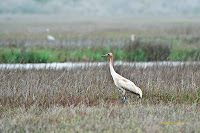As I stroll along the boardwalk in the Aransas National Wildlife Refuge, I close my eyes and see the mastodons and ancient camels kicking up sand under their huge hoofs. The smell of brine touches deep memories of a time before me. I imagine I hear the bugle-call of thousands of whooping cranes that have come to the Texas Coast for the winter. I feel a deep connection to these endangered birds, as did the hundreds of folks who joined me last weekend for the 16thAnnual Whooping Crane Festival on Mustang Island in Port Aransas, Texas.
Although Saturday morning greeted us with blowing rain, more than seventy dedicated birders boarded the Wharf Cat for a boat cruise to the refuge to see these majestic birds. I’ve taken this trip dozens of times, but today was special. Dr. George Archibald, cofounder of the International Crane Foundation, narrated the cruise. I had a chance to meet and talk with him and I learned a few new whooper facts. Did you know the entire current wild population of whooping cranes descended from the only three females left in the population of fifteen cranes that existed in 1942? Thanks goodness these ladies had good genes.
On Saturday afternoon, I visited prime birding spots on Mustang Island. The Turnbull Birding Center, near the ferry landing, provides a boardwalk out into a brackish marsh where hundreds of waterfowl feed and float among the reeds. Pin-tailed ducks, coots, black-bellied whistling duck, great blue herons, cormorants, least grebes, cinnamon teal, moorhens, and roseate spoonbills frequent the ponds. Nearby, the two-acre Paradise Pond, the only freshwater wetland on the island, attracts neo-tropical migrants such as Ana’s Hummingbird, tropical parula and varied bunting. On the 3.5-acre wetlands on the UT Marine Science Institute grounds, I spotted a family of four night herons roosting in a tangle of vegetation. Just driving along the shoreline, I snapped photos of ruddy turnstones, willets, semipalmated plovers, and the ever-present laughing gulls. As an added bonus, a white-tailed hawk sat patiently in his rehab cage on campus as I took his picture. I said a prayer that this gorgeous bird would one day be released into the wild.
Next week I will have my photos downloaded and posted. Right now, I’m in New Orleans. My three sisters, niece, and I will run the ½ Marathon this morning. For now, here’s a photo of a moorhen taken while in Florida two years ago.
My great friends Mike Sloat and his partner Fran treated me to a cruise to the refuge on Monday morning, this time in Captain Kevin Simm’s birding boat, which allowed us to get close to the cranes. Mike trusted me with his camera equipment, and I snapped more than two hundred photos of whooping cranes, skimmers, oystercatchers, white ibises, willets, terns, and ring-billed gulls.
Mike is an incredible wildlife photographer and his photos will be used for the cover of my book, The Man Who Saved the Whooping Crane: The Robert Porter Allen Story, which will be out in September. Check out Mike’s website. http://www.mikesloat.net/




Hey Kathleen,
This sounds very cool, wow. I recently spent a week in Dominican on a beautiful resort, where they had peacocks and pink flamingos. There was a tall, white bird that might have been a Heron, I'm not an avid birder, but it was beautiful, anyway. The male peacocks made a strange sound that almost sounded like a cat meowing. My 2-year old grandson thought they were screaming 'help, help!'. It kinda freaked him out, LOL.
Nancy,
Peacocks do make an eerie sound. I may have to use the "help, help" in a mystery one day.
The large white bird you saw was probably a Great egret.